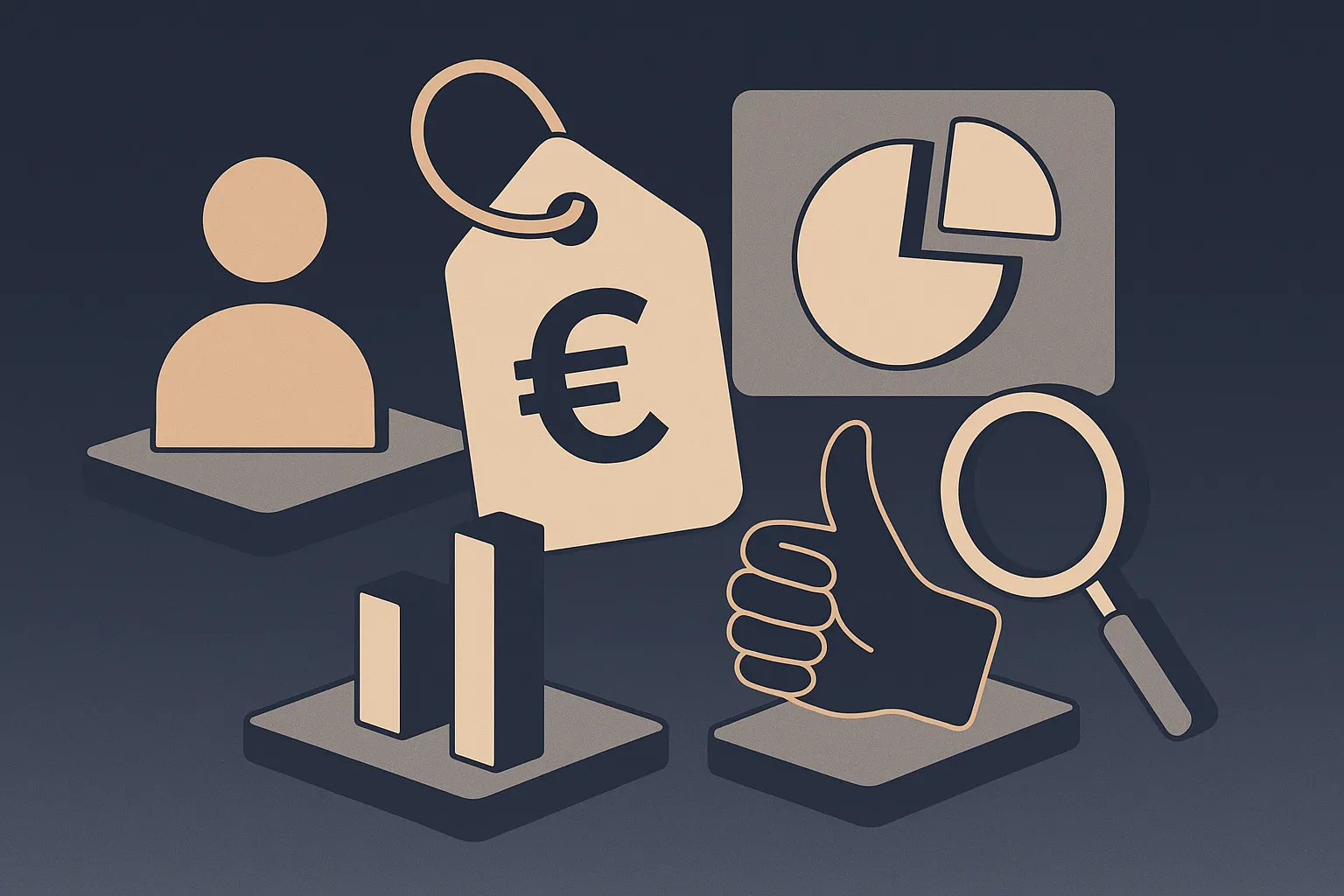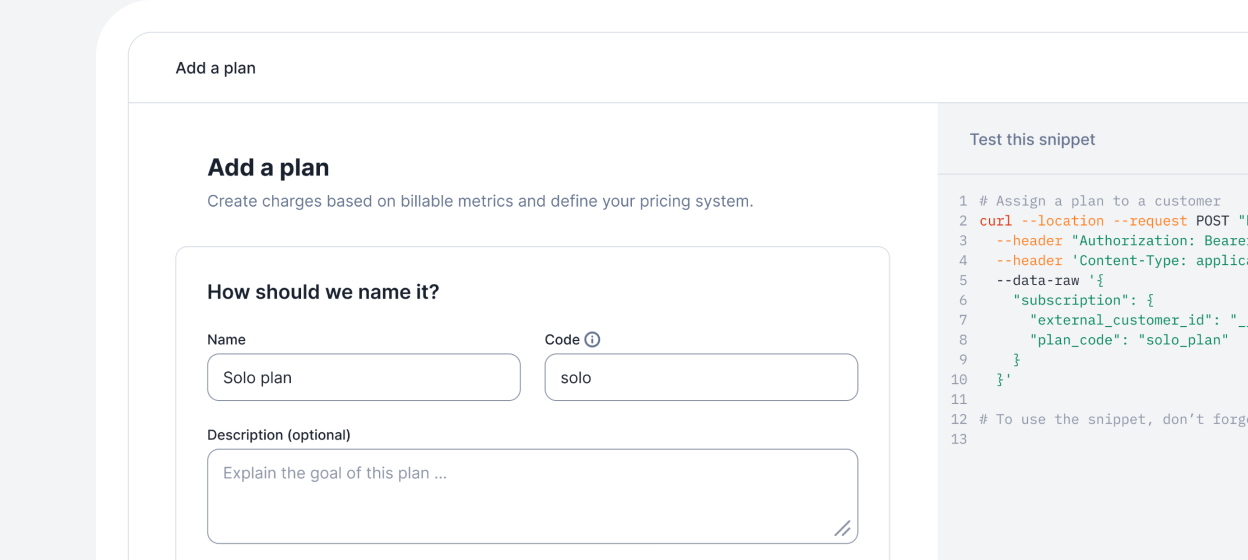What is value-based pricing and how does it work?

Value-based pricing leverages psychological principles to align pricing with customer-perceived value, making it particularly powerful when combined with modern consumption based pricing models and hybrid pricing strategy approaches. Understanding how psychological factors influence pricing decisions enables SaaS and AI companies to create compelling pay as you go pricing models that maximize both adoption and revenue.
The Psychology of Value-Based Pricing
Psychological Anchoring in Value Perception
Value-based pricing success depends heavily on price anchoring - customers' mental reference points that influence their perception of fairness and value. The underlying intuition behind the value-based pricing strategy is that the price of a good or service should reflect the benefits and implied value that the customer expects to receive [1].
High-value anchoring strategies:
- Display enterprise-scale usage first: "Process 50M API calls/month for $0.002 per call"
- Make standard usage appear accessible: "Process 100K API calls/month for $0.01 per call"
- Position entry tiers as minimal investment: "First 10K API calls free, then $0.015 per call"
AI consumption pricing models create natural anchoring opportunities by showcasing enterprise-scale consumption first, making lower tiers feel accessible and entry points minimal.
The Decoy Effect in Value-Based Tiers
Strategic tier positioning drives customers toward higher-value options through psychological comparison effects:
Value-based decoy structure:
- Basic: 50K tokens/month at $0.020 per token ($1,000/month)
- Standard (Decoy): 100K tokens/month at $0.018 per token ($1,800/month)
- Professional: 100K tokens/month + premium AI features at $0.015 per token ($1,500/month)
The Standard tier makes Professional appear exceptional value, driving customers toward higher-margin premium features while increasing AI consumption pricing models adoption.
Hybrid Pricing Strategy Psychology
Psychological Benefits of Hybrid Models
The hybrid model is, as it sounds, a blend of fixed subscription pricing and usage-based pricing. It protects SaaS companies from highly variable revenue forecasting while also capturing incremental revenue from customers using the product more than others [2].
Psychological advantages:
- Base subscription comfort: Familiar recurring fee reduces adoption friction
- Usage upside opportunity: Customers see expansion potential without commitment fear
- Value alignment: Pay-as-you-grow model feels inherently fair
Usage-based billing directly connects cost with consumption, ensuring customers pay only for what they use. This fosters a stronger connection between the value you deliver and the price customers pay [3].
Overcoming Psychological Barriers
Predictability anchoring: PAYG can present predictability challenges for both customers and vendors. Some customers may be uncomfortable with the uncertainty of the pricing model, while others might be fine with it but get angry if they end up with a billing surprise due to usage spikes or poor forecasting [4]
Solutions through psychological design:
- Control mechanisms: Real-time usage dashboards and hard spending limits
- Consumption forecasting: Historical patterns showing "typical customer usage ranges"
- Graduated pricing: Gentle tier progression reducing cost shock
- Success framing: Position higher usage as business growth indicator
Consumption-Based Pricing Psychology
Pay-As-You-Go Pricing Models Psychology
The pay-as-you-go (PAYG) pricing model in SaaS charges customers based on their consumption of the service [4]. This model appeals to customer psychology by:
Lower barriers to adoption: Lower upfront costs and reduced barriers make it simpler for potential customers to try out and adopt a service, without the mental load and need to estimate capacity. Easier adoption encourages experimentation and can expand your market reach [4]
Psychological fairness: For SaaS companies with significant usage-driven costs, a PAYG model provides tighter margin control. When the right pricing metric is chosen, it links revenue and costs to consumption, creating more consistent unit economics per customer [4]
Metered Billing for SaaS Psychology
Metered billing, also known as usage-based billing, is a billing structure that charges customers based on their monthly usage of a product or service in the Software as a Service (SaaS) industry. Metered billing aligns costs directly with usage, making customers pay only for what they use [5].
Customer-centric metric selection:
- Developer tools: "Projects deployed" vs "CPU hours consumed"
- Analytics platforms: "Insights generated" vs "Data rows processed"
- AI services: "Documents analyzed" vs "Inference operations"
Psychological onboarding strategies:
- Free usage tiers for risk-free initial adoption
- Consumption forecasting tools reducing uncertainty anxiety
- Success-based messaging connecting usage growth to business outcomes
- Transparent billing with real-time consumption visibility
AI Consumption Pricing Models Strategy
AI-Specific Psychological Considerations
AI consumption pricing models create unique psychological opportunities due to variable computational outcomes:
Token-based clarity: Make computational consumption understandable through relatable business metrics Outcome anchoring: Frame pricing around business results rather than technical resources Predictable bursting: Allow consumption spikes while maintaining cost control
Example: AI Content Generation Service
- Starter: 10K tokens/month ($29) - "Create 50 blog posts monthly"
- Growth: 100K tokens/month ($199) - "Scale content for growing audience"
- Business: 1M tokens/month ($899) - "Enterprise content operations"
Value Communication Psychology
Value-based pricing is a customer-centric pricing approach that requires a thorough understanding of customer preferences and needs, and product improvements to ensure the identified needs are sufficiently met. However, the effective communication of the product's value to customers is a critical variable needed to justify the price [1].
How Lago Enables Psychological Value-Based Pricing
Technical Infrastructure Supporting Psychology
Lago's high-performance usage-based billing system provides the technical foundation for sophisticated psychological pricing strategies:
Real-time psychological transparency: Process up to 15,000 billing events per second, enabling accurate metering for high-volume AI consumption pricing models scenarios. This capability supports the transparency needed for customer trust in value-based models while reducing psychological barriers to adoption.
Flexible psychological tier configuration: Bill usage with flexible pricing including tiers, packages, and custom models, enabling sophisticated decoy effects and anchoring strategies through configurable consumption breakpoints that guide customer psychology toward optimal selections.
Predictable hybrid model support: Set up recurring platform fees alongside prepaid credits with custom top-up rules, directly addressing psychological concerns about cost unpredictability while maintaining usage-based value capture opportunities.
Business Psychology Acceleration
Faster psychological trust building:
- Automated billing workflows reducing manual invoice processing time by 80%
- Real-time revenue recognition providing immediate visibility into usage-based revenue
- Reduced billing errors through precise event processing, building customer confidence
Improved customer psychology through experience:
- Transparent consumption tracking builds trust through usage visibility
- Flexible pricing iterations enable optimization without customer disruption
- Self-service billing management reduces support friction while improving satisfaction
Advanced Psychological Pricing Features
Consumption forecasting psychology: Built-in analytics help customers predict their usage patterns, reducing psychological barriers to adoption by addressing uncertainty anxiety.
Graduated complexity management: Start with simple usage tiers and progressively introduce sophisticated pricing rules as customers scale, preventing analysis paralysis.
Multi-dimensional value alignment: Support flexible hybrid pricing strategy approaches that align costs with value delivered through multiple usage metrics within single customer relationships.
Implementation Framework for Psychological Value-Based Pricing
Strategic Psychological Design
Value-aligned metrics definition: Choose metrics that feel directly connected to customer value rather than technical infrastructure costs:
- Outcome-based messaging: "Pay for results generated" rather than "Pay per API call"
- Success-aligned pricing: Usage increases correlate with customer business growth
- Transparent value exchange: Clear connection between consumption and business impact
Tier structure psychology:
- Good-Better-Best positioning with clear consumption breakpoints
- Most Popular badges on target usage tiers to guide selection
- Volume discount visualization showing per-unit cost reduction
- Upgrade path clarity demonstrating natural progression routes
Technical Implementation Requirements
Metered billing system capabilities:
- Real-time dashboards showing current consumption and projected costs
- Detailed invoicing breaking down usage charges by metric and time period
- Consumption analytics helping customers optimize their usage patterns
- Billing predictability tools forecasting monthly charges based on trends
Advanced psychological features:
- Usage limit notifications when approaching tier boundaries
- Overage policy transparency with clear per-unit costs for excess usage
- Consumption pattern analysis showing business growth correlation
Industry Success Metrics and Examples
Psychological Pricing Impact
Revenue retention improvements: Implementing a metered billing system can potentially increase a company's net revenue retention (NRR). HubSpot, for example, saw its NRR jump from 70% to nearly 100% after switching to metered billing [5]
Customer satisfaction correlation: Companies with usage-based pricing typically have higher NPS and CSAT scores compared to the broader SaaS index [6]
Market Evolution Trends
UBP adoption is down slightly year-on-year from 46% to 41%. Looking more closely at the data, the pendulum has been shifting away from pure usage-based or pay-as-you-go pricing and toward "hybrid" pricing models that combine usage and subscription pricing in creative ways [7].
This trend reflects psychological preferences for predictability combined with fairness, making hybrid pricing strategy approaches the optimal solution for most SaaS companies.
Getting Started with Psychological Value-Based Pricing
Implementation Roadmap
- Define psychologically-aligned value metrics that customers perceive as directly connected to outcomes
- Design anchoring tier structures using decoy effects and psychological pricing principles
- Implement transparency mechanisms providing real-time visibility and forecasting tools
- Deploy flexible billing infrastructure capable of supporting complex psychological pricing strategies
Critical success factors:
- Make pricing initiatives an OKR-level priority with cross-organizational buy-in
- Invest in billing technology that processes high-volume events with transparency
- Focus on customer communication about value rather than just features
- Continuously optimize based on psychological response and usage patterns
Ready to implement psychologically-optimized value-based pricing that leverages consumption based pricing models and AI consumption pricing models? Lago's usage-based billing system provides the high-performance infrastructure needed to support sophisticated psychological pricing strategies while processing up to 15,000 billing events per second with the transparency and flexibility that builds customer trust and drives revenue growth.
Focus on building, not billing - whether you choose Lago Premium for enterprise control or deploy the open-source version for flexibility, you'll never worry about billing complexity again while optimizing for customer psychology and business outcomes.
Focus on building, not billing
Whether you choose premium or host the open-source version, you'll never worry about billing again.
Lago Premium
The optimal solution for teams with control and flexibility.

Lago Open Source
The optimal solution for small projects.

